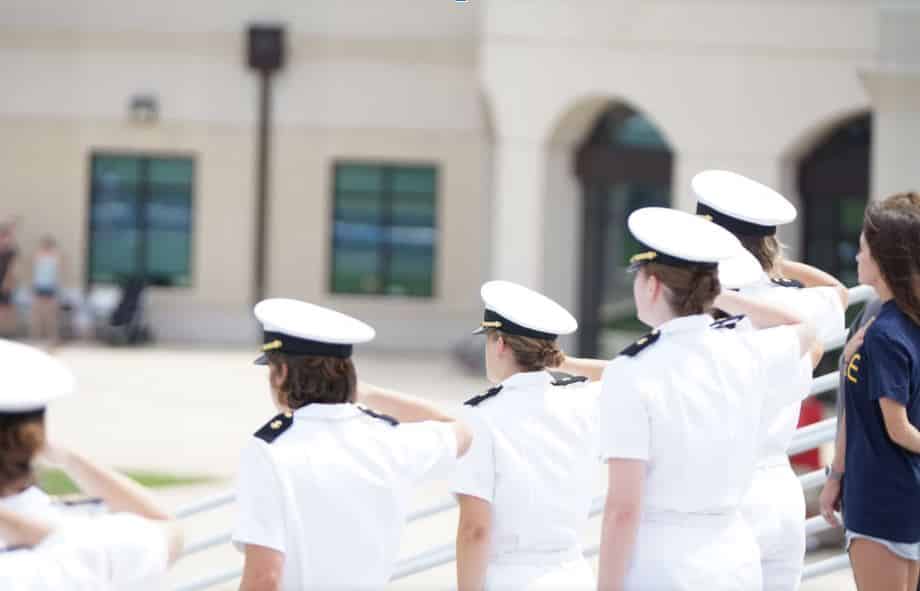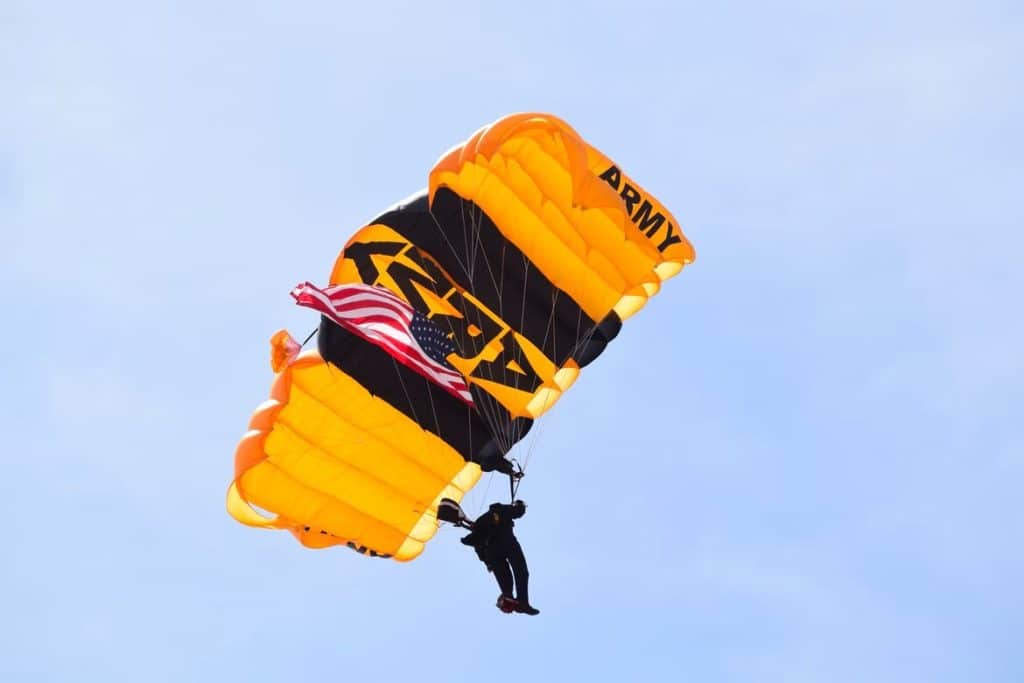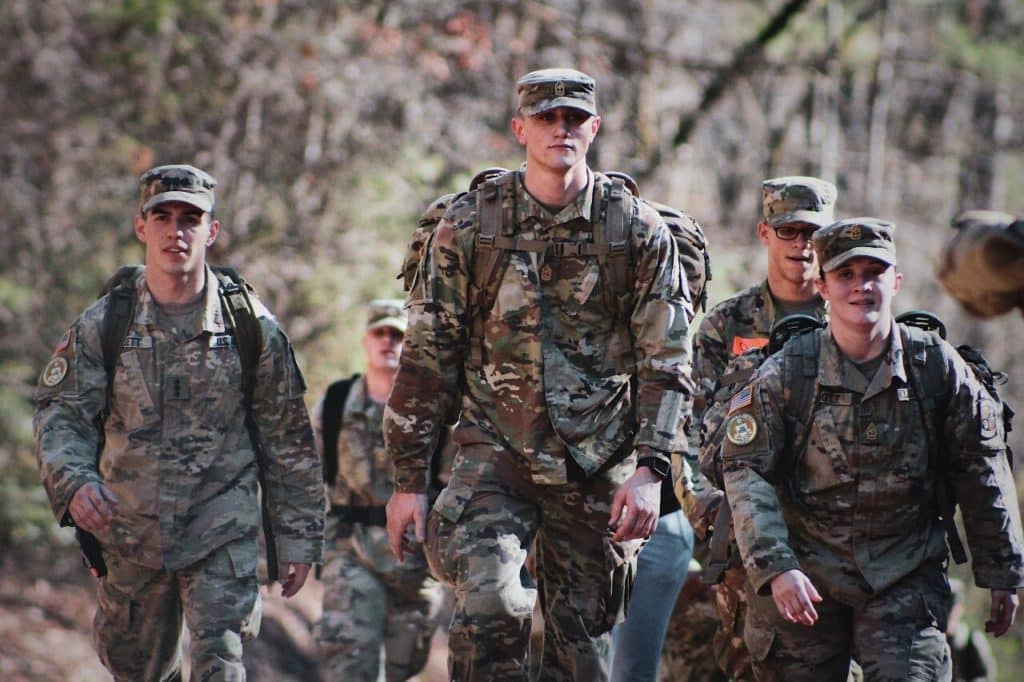
Both JROTC and ROTC offer you opportunities to train to become a reserve officer in the U.S. Army, Navy or Air Force. Find out if studying at a college with ROTC programs is right for you with this ultimate guide. Explore steps to join, types of programs, uniform and rank information, benefits of joining and scholarships available for prospective students.
JROTC
Build skills in self-confidence, leadership, nutrition and career success with a JROTC program. According to The RAND Corporation, there are over 500,000 students in programs across the United States in all five participating service branches.
JROTC Meaning
JROTC, or the Junior Reserve Officers’ Training Corps, was first established in 1916. It operates in over 1,700 public and private high schools, correctional centers and military institutions. It includes a rigorous curriculum, co-curricular activities, scholarship opportunities and college credit availability.
Types of JROTC Programs
Title 10, Section 2031 of the United States Code congressionally mandates each military service to have a JROTC program. This means there are programs available for the following branches of the military:
There are a number of teams and programs you can participate in as part of your JROTC co-curricular activities:
- Color Guard members compete in precision marching drills and present the flag in various settings.
- CyberPatriot competitions encourage participants to pursue education and careers in the field of cybersecurity.
- Raider Team groups practice military skills and participate in competitions that test their physical and mental strength.
- Rifle Teams participate in marksmanship competitions.
- STEM Camp emphasizes experiential learning in the areas of science, technology, engineering, and mathematics.
- JROTC Leadership and Academic Bowl (JLAB) competitions test leadership skills and prepare members for college.
How to Join JROTC
To join JROTC, you must be enrolled in a participating high school. Consider the type of JROTC program you wish to attend. To participate in a program, you must pass determining eligibility criteria in the following areas:
- Citizenship
- High school enrollment
- Physical fitness
Citizenship requirements include being a citizen, national or lawfully admitted permanent resident of the United States. You can only attend the JROTC program of your enrolled high school. Different branches of the military have different physical fitness requirements for service. For example, you must go through the Semper Fit Fitness Program and undergo physical evaluations to certify you’re fit to join the Army JROTC program.
JROTC Ranks
Just like active military units, JROTC units are divided into specific, hierarchical ranks. Here are the JROTC ranks in order:
- Cadet Private
- Cadet Private First Class
- Cadet Corporal
- Cadet Sergeant
- Cadet Staff Sergeant
- Cadet Sergeant First Class
- Cadet Master Sergeant
- Cadet First Sergeant
- Cadet Sergeant Major
- Cadet Command Sergeant Major
- Cadet 2nd Lieutenant
- Cadet 1st Lieutenant
- Cadet Captain
- Cadet Major
- Cadet Lieutenant Colonel
There are specific promotion requirements for each level. Typically, you must perform drills, have a recommendation and avoid disciplinary actions to qualify for a promotion. As a higher-ranking cadet, you’ll have additional opportunities to grow in leadership roles and responsibilities.
JROTC Uniform
The JROTC uniforms come in four basic types:
- Class A
- Class B
- ACU, or camouflaged field uniform
- PT, or physical training
Uniforms for JROTC cadets are the same as the uniform worn by the specific military service. These uniforms have specific requirements according to the dress and personal appearance policies of the military service. Regardless of the uniform you wear, it must follow the four elements of uniform wear: military image, cleanliness, neatness and safety.
As a JROTC cadet, you’ll typically need to wear your uniform at least once a week. Here are some examples of uniform components that you must adhere to precisely:
- Beret color
- Insignias, badges and shoulder cords
- Undershirt, socks and shoes
- Jewelry
- Hair, fingernails and other grooming
- Drill rifle
Uniforms are completely provided by the instructor, except for a white T-shirt and dress socks. You’ll receive training in proper dress code, how to care for your uniform and when to wear specific uniforms.
Benefits of Joining JROTC
Every JROTC program offers a number of personal, professional and academic benefits. Joining the ROTC doesn’t force you to enroll in a college with ROTC programs or join the military. If you do wish to pursue a career in the military, however, a JROTC program can be a great first step.
Academically, you can prepare for college or other opportunities with the following benefits:
- Assistance filling out the FAFSA
- Additional scholarship and grant opportunities
- Personal references from JROTC instructors
- High school elective or physical education credit, depending on your school and program
There are also many personal benefits to choosing to join a JROTC program. These include some of the following personal improvements:
- Self-confidence
- Leadership
- Discipline
- Time management
- Collaboration
- Communication
- Accountability
- Community service
- Problem-solving skills
Top JROTC Programs in the Country
All JROTC programs are ranked based on a number of factors. One of the most coveted awards for a unit is to be named an Honor Unit with Distinction. Explore the available Marines JROTC programs and other programs to find a unit that’s received this prestigious award. Here are some evaluations units must undergo to win this and other distinctions:
- Unit report
- Service learning briefing
- Continuous improvement project briefing
- Instructor and cadet portfolios and interview
ROTC
With a longer history and a more significant commitment than the JROTC, the ROTC offers you more opportunities to join the military, receive a college degree or advance in your career. Find out more about the key features of ROTC, the skills you may learn through a program and the requirements for entering and completing a program at your chosen college.
ROTC Meaning
Formally known as the Reserve Officers’ Training Corps, ROTC is a program that offers two distinct options:
- Limited participation with no military service requirement
- Full participation with up to eight years of required service after graduation
The roots of ROTC go back as far as 1819 when Captain Alden Partridge founded the American Literary, Scientific and Military Academy. Located in Norwich, VT, the academy was designed to create citizen-soldiers who combined military training and civilian occupational studies in one individual.
Types of ROTC Programs
The benefits of ROTC in college include significant scholarship support, life-changing skill building and the opportunity to serve your country, either full time or part time in the U.S. Army Reserve or similar program.
The Coast Guard only offers a JROTC program and a College Student Pre-Commissioning Initiative, rather than a formal ROTC program. The other branches of the military all offer ROTC programs at select colleges and universities:
Just like the JROTC programs, each ROTC program offers distinct differences. The application process, eligibility requirements, uniform and benefits can vary, so consider which program best suits your passions and career goals as you look for one to join.
Requirements to Join ROTC
The requirements to join an ROTC program vary. Despite popular belief, not every student accepted into a program is awarded a scholarship. ROTC programs offer two-, three- and four-year competitive scholarships.
While you should check with an individual school and ROTC program to see specific requirements, here are some basic standards you typically need to pass to apply:
- Be between 17 and 26 years old
- Be a U.S. citizen
- Have a high school diploma or equivalent
- Have at least a 2.50 high school GPA or 2.0 college GPA
- Pass the physical fitness standards for your chosen program
You must also accept the service requirements before you enroll in the program. While you won’t be deployed while you’re a student in an ROTC program, you will have to serve a predetermined length of time after graduation.

ROTC Chain of Command
Cadets in the ROTC have six officer ranks and 10 NCO, or non-commanding officer, ranks. Here are the cadet ranks, in order:
- Cadet Private
- Cadet Private First Class
- Cadet Corporal
- Cadet Sergeant
- Cadet Staff Sergeant
- Cadet Sergeant First Class
- Cadet Master Sergeant
- Cadet First Sergeant
- Cadet Sergeant Major
- Cadet Command Sergeant Major
- Cadet Second Lieutenant
- Cadet First Lieutenant
- Cadet Captain
- Cadet Major
- Cadet Lieutenant Colonel
- Cadet Colonel
Besides the individual ranks, the Army also uses a specific organizational structure:
- Battalion
- Company
- Platoon
- Squad
ROTC Branching Process
With over 17 distinct Army branches to choose from, ROTC branching is critical to find the right assignment for you as a cadet. In the Army ROTC program, this process is called Talent Based Branching.
This process finds the optimal branch for you based on several key factors, like physical fitness, volunteer experience and GPA. Branches include specific areas of service and specialty, including Cyber, Aviation and Engineer.
ROTC Uniform
The specific uniform you wear as a student in an ROTC program depends on the military branch. At the basic level, you’ll be given the same four types of uniforms worn by JROTC cadets:
- Class A
- Class B
- ACU
- PT
The decorations, insignia and awards are specific to ROTC. The Class A uniform in particular varies between male and female options. There are very strict rules and regulations for appropriate situations to wear your uniform and how to care for it, which you’ll learn through your ROTC program.
ROTC Benefits
Similar to the benefits of ROTC in high school, ROTC college programs help you prepare for military service, educational goals and a civilian career. Here are some of the most common benefits you may receive as a cadet:
- Leadership training: ROTC helps you build and prepare to be a leader in your future. Whether you’re organizing community events or leading a squad in the future, you can make confident decisions in fast-paced, stressful situations.
- Physical fitness: As a cadet, you must pass a minimum physical fitness test. You’ll also have many opportunities throughout the program to build up your physical fitness.
- Career training: You aren’t just learning how to become a soldier or become physically fit. As an ROTC cadet, you’re learning practical job skills in one of 17 fields. Don’t just learn how to work in a tight-knit team or fly a helicopter, but learn nursing, engineering, coding or other skills in both military and civilian careers.
- Scholarship opportunities: You may receive a full four-year scholarship that covers tuition and room and board. While not every cadet receives a full scholarship, there are a number of competitive scholarships available to pay for your degree.
Top ROTC Programs in the Country
Because of the large number of colleges with ROTC programs, it’s important to search carefully for the best option for your specific situation. Here are some factors to weigh as you look for the best college with ROTC programs for you:
- ROTC military branch
- Scholarship opportunities
- MacArthur Award winner
- Strength of your desired degree program
- Location
- Campus size
- Physical fitness and leadership development ratings
Just like other college and university ratings, finding the best ROTC program can be challenging and subject to opinion. Consider for yourself which factors are most important to you and where you wish to apply as a college student and cadet.

Lessons Learned From JROTC/ROTC
Both JROTC and ROTC offer lifelong lessons for you as a cadet. Learn from successful cadets about the ways one or both of these programs can help you succeed and learn critical lessons. You aren’t just finding a way to pay for college, but you’re embarking on a journey that builds your personal character, confidence, leadership skills and career expertise.
How JROTC / ROTC Can Help You Succeed
Both the JROTC and ROTC programs are designed to help you succeed in the following ways:
- Personally: Physical fitness and a sense of purpose are invaluable skills you may receive from a program. Getting in shape is more about improving your looks, but helps expand your physical capabilities, self-confidence and health. A sense of purpose often comes from knowing you’re contributing to something larger than yourself.
- Academically: Paying for college is a serious limitation for many students. Instead of taking on large amounts of debt or missing out on an opportunity to receive a bachelor’s degree, apply for ROTC scholarships to receive the academic training you deserve.
- Professionally: A JROTC or ROTC program provides elective course and degree program opportunities to receive real-world training in practical areas. Whether you choose to continue your career in the military or pursue a civilian career after your service is complete, you’ll have competitively paid, in-demand skills that can improve your application.
- Socially: Between your tight-knit squad, other officers and an alumni network, both ROTC and JROTC offer opportunities to make lifelong friends. Accomplishing challenging tasks together creates significant bonds that often extend beyond the length of your service requirement.
These are just some of the most commonly reported ways these programs can help you succeed. They both can be as rewarding as you make them, so find a program that fits your goals and look for opportunities to make a difference through your chosen option.
Lessons Learned From JROTC/ROTC
Both programs offer significant opportunities to learn lifelong lessons. The benefits of both programs aren’t just skills and friends, but lessons that can be passed on to others. Consider these examples of lessons learned:
- Why friendship matters
- How to work as a team
- Why you should take responsibility for your actions
- How to persevere through challenges
- How to avoid making excuses for situations
- When to reach out for help
- How to manage time and commitments
These lessons can be learned in other programs, but both JROTC and ROTC offer unique opportunities to learn them in real-life situations. They can also foster a sense of duty and purpose as you give back to your nation and serve your community in various ways.
The specific lessons you learn may vary. Just like any other experience, the skills, lessons and attitudes you take away from JROTC and ROTC depend on how you frame your experiences and how you take on commitments and challenges. Thankfully, talented instructors and officers help guide you through the process in constructive ways.
Scholarships Opportunities
While you have the opportunity to pay for college with ROTC programs, the specific scholarship opportunities vary. Joining a JROTC high school program can also qualify you for some scholarship and grant opportunities.
JROTC Scholarships and Grants
There are over 300 colleges offering scholarship opportunities to high school students currently enrolled in a JROTC program. You could receive an award for a few hundred or a few thousand dollars per year for college.
The JROTC programs themselves don’t offer scholarship opportunities, but success in your chosen program may strengthen your application for an ROTC program.
ROTC Scholarships and Grants
Every branch of the military offers distinct ROTC scholarships. While the features differ, all offer opportunities to pay for tuition and living expenses for a four-year degree.
Army scholarships include the following options:
- Two-, three- and four-year scholarships
- Army Nursing scholarships
- Green-to-Gold scholarships
- Guaranteed Reserve Forces Duty scholarships
Air Force scholarships include three types:
- Type 1: Pays 100 percent of tuition and provides monthly stipends for living expenses and books.
- Type 2: Offers up to $18,000 per year, including living and book stipends.
- Type 7: This unique scholarship includes all the features of a Type 1 scholarship for in-state education, or it can be used as a Type 2 scholarship for up to three years to pay for out-of-state tuition.
Navy scholarships offer similar features, including full tuition coverage and additional fees. In some cases, these scholarships also cover monthly subsistence and books.
Coast Guard College Student Pre-Commissioning Initiative scholarships cover full tuition for up to two years of college. This includes books, fees, housing, medical and a Coast Guard salary. There are other Coast Guard officer programs, including Coast Guard Academy, that allow you to earn a degree and train in the Coast Guard with little or no tuition costs.
Review the unique application requirements for every branch of the military to find the right program for you. Every JROTC and ROTC program comes with requirements and challenges, but they may offer the next step you need in your career.